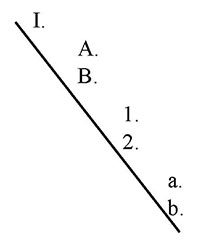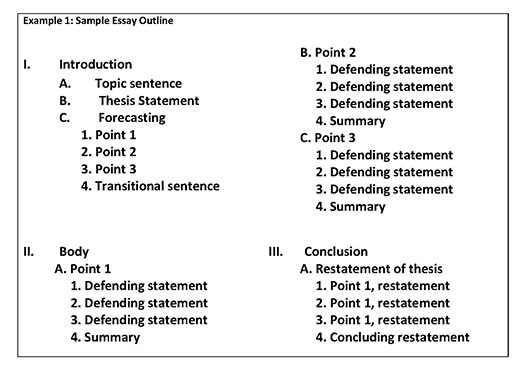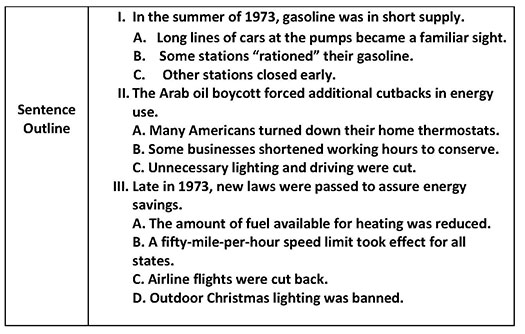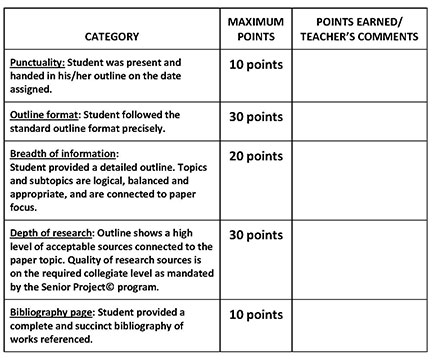- Essay Outline Template
- Senior Project’s Research Paper Phase 1: Outlining
- The Purdue OWL: Sample Outlines
- Senior Project Outline Rubric
- Senior Project Final Paper Rubric
Helpful links
MLA Guidelines: https://owl.english.purdue.edu/owl/resource/747/01//
For documenting sources, taking notes and outlining your paper: http://www.noodletools.com/
For submitting your research paper: turnitin.com
Essay Outline Template
Essay Outline Template
To begin:
Thesis Statement: Above Roman numeral I, specifically state your thesis. Then begin your outline based upon the structure below.
I. Introduction
- Get the reader’s attention by asking a leading question or relaying something enticing about the subject in a manner that commands attention (“a hook”). Start with a related quote, alluring description, narration or a germane anecdote.
- State the thesis of the paper, the causes and effects to be discussed, a comparison of subject X and subject Y, your proposal (if applicable), and the main points that will develop your argument.
II. Body Paragraphs: The Subtopics That Support Your Thesis
Remember: Only one topic is discussed within a single paragraph.
- Your major point, assertion, explanation
- Supporting evidence (examples, facts, statistics, quoted authorities, details, reasons, examples) with proper citing
- Supporting evidence with proper citing
- Second explanation
- Supporting evidence with proper citing
- Supporitng evidence with proper citing
- Third explanation (if applicable)
- Supporting evidence with proper citing
- Supporting evidence with proper citing
Key points about the body paragraphs section:
- Repeat the body paragraphs format each time you introduce a new subtopic, assigning it the next Roman numeral in the sequence
- Every paragraph must finish with a “clincher sentence,” the final statement which brings the paragraph to satisfying conclusion and bridges the next paragraph.
- Check your work: If at any point you have a sentence(s) that is not relevant to the paragraph’s topic sentence, GET RID OF IT. By including this sentence, you give this section irrelevancy.
- When you use information found in one of your sources in the body of the paragraph, make sure to include the citation immediately after that sentence.
III. Conclusion
First, put as much time into the conclusion paragraph as you did in the introduction and body paragraphs.
Your conclusion is your chance to have the last word on your Senior Project paper subject. The conclusion allows you to have the final say on the issues you have raised in your paper, to summarize your thoughts, to demonstrate the importance of your ideas, and to propel your reader to a new view of the subject. It is also your opportunity to make a good final impression and to end on a positive note. The conclusion pushes beyond the boundaries of the thesis and allows you to consider broader issues, make new connections, and elaborate on the significance of your findings. Your conclusion gives your reader something to take away that will help them see things differently, appreciate your topic in personally relevant way, and can suggest broader implications that will not only interest your reader but also enrich your reader’s life in some way.
Here are some techniques to help you write the conclusion portion of your outline:
- Go through your research once again. Was there a piece of information that was really good but didn’t quite fit into the introduction or body paragraphs? See if it’s applicable/useful in your conclusion paragraph and use it here.
- Return to the theme or themes in the introduction. This strategy brings the reader full circle. For example, if you begin by describing a scenario, you can end with the same scenario as proof that your essay is helpful in creating a new understanding. You may also refer to the introductory paragraph by using key words or parallel concepts and images that you also used in the introduction.
- Synthesize, don’t summarize: Include a brief summary of the paper’s main points, but don’t simply repeat things that were in your paper. Instead, show your reader how the points you made and the support and examples you used fit together. Pull it all together.
- Include a provocative insight or quotation from the research or reading you did for your paper.
- Propose a course of action, a solution to an issue, or questions for further study. This can redirect your reader’s thought process and help her to apply your info and ideas to her own life or to see the broader implications.
- Point to broader implications.
Avoid these conclusion pitfalls:
- Beginning with an unnecessary, overused phrase such as “in conclusion,” “in summary,” or “in closing.” Although these phrases can work in speeches, they come across as wooden and trite in writing.
- Stating the thesis for the very first time in the conclusion.
- Introducing a new idea or subtopic in your conclusion.
- Ending with a rephrased thesis statement without any substantive changes.
- Making sentimental, emotional appeals that are out of character with the rest of an analytical paper.
- Including evidence (quotations, statistics, etc.) that should be in the body of the paper.
By following the techniques above, the writing of the conclusion paragraph for the paper should be a breeze!
(Additional sources used: Capitol Community College Foundation, St. Helen’s K-12 School District, University of North Carolina at Chapel Hill Writing Center.)
Phase 1 Outlining
Senior Project’s Research Paper Phase 1: Outlining
(Sources: The Owl at Purdue University and Writer’s, Inc.)
Outlining: Why Outline?
- Aids in showing the hierarchical relationship or logical ordering of information
- Aids in the process of writing
- Helps to organize ideas
- Presents material in a logical form
- Shows the relationships among ideas in your writing paper
- Constructs an ordered overview of your writing
- Defines boundaries and groups
- Helps to alleviate writer’s anxiety (“writer’s block”) as the information is now directly in front of you.
Outlining: How to Create an Outline
- Determine the purpose of your paper
- Determine the audience for whom you are writing
- Develop the thesis of your paper
- Brainstorm: list all of the ideas that you want to include in your paper
- Organize: group related ideas together
- Order: arrange material in subsections from general to specific or from abstract to concrete
- Label: create main and subheadings
Outlining: Types of Outlines…There are three types to consider:
- Alphanumeric
- Full sentence
- Decimal
- Senior Project will use alphanumeric
Outlining: Alphanumeric
The alphanumeric format of outlining is the most recognizable and follows a very specific structure:
- Roman numerals (I, II, III, etc.)
- Capitalized letters (A., B., C., etc.)
- Arabic numerals (1., 2., 3., etc.)
- Lowercase letters (a., b., c., etc.)
Again, this is the only format accepted by Senior Project.
Outlining: Dividing the Information
Each of the segments of the alphanumeric mode of outlining has a specific purpose:
- Roman numerals represent the heading of each section (the main ideas). These are the most general.
- Capitalized letters represent the first level of specificity (these are more specific than the Roman numerals).
- Arabic numerals and lowercase letters are the true specifics of your information.
Outlining: Structure
The structure of an outline is based upon a downward slant or slash as follows:
(The line is for illustrative purposes only – don’t draw it!)
Outlining
Ok, let’s look at the example that is provided to you for better understanding.
Bibliography: For the bibliography, use Noodletools.com
Four Main Components for Effective Outlines
Summary: This resource describes why outlines are useful, what types of outlines exist, suggestions for developing effective outlines, and how outlines can be used as an invention strategy for writing. Ideally, you should follow these four suggestions to create an effective outline.
Four Main Components for Effective Outlines by the OWL at Purdue: https://owl.english.purdue.edu/owl/owlprint/544/
Purdue OWL Sample Outlines
The Purdue OWL: Sample Outlines
Alphanumeric Outline
________________The College Application Process
I. Choose Desired Colleges
__A. Visit and evaluate college campuses
__B. Visit and evaluate college websites
____1. Look for interesting classes
____2. Note important statistics
II. Prepare Application
__A. Write personal statement
____1. Choose interesting topic
______a. Describe an influential person in your life
_________(1) Favorite high school teacher
_________(2) Grandparent
______b. Describe a challenging life event
____2. Include important personal details
______a. Volunteer work
______b. Participation in varsity sports
__B. Revise personal statement
III. Compile Résumé
__A. List relevant coursework
__B. List work experience
__C. List volunteer experience
____1. Tutor at foreign language summer camp
____2. Counselor for suicide prevention hotline
Full Sentence Outline
__I.__Man-made pollution is the primary cause of global warming.
_____A.__Greenhouse gas emissions are widely identified by the scientific
________community to be harmful.
__________1.__The burning of coal and fossil fuels are the primary
_____________releasers of hazardous greenhouse gases.
Full sentence outlines are often accompanied with an APA reference list
on a separate page. Quotes within the outline must also utilize APA in-text citations.
Decimal Outline
__1.0_Choose Desired College
_____1.1_Visit and evaluate college campuses
_____1.2_Visit and evaluate college websites
________1.2.1_Look for interesting classes
________1.2.2_Note important statistics
Outlining
The outline provides a skeleton of basic ideas upon which the writer adds flesh. The careful listing of subtopics under main topic headings focuses the writer’s attention and identifies any areas which need more development.
There are two types of outlines – topic and sentence. The first type, which consists of phrases, requires fewer words and is easier to construct. The second type is constructed out of whole sentences which can be lifted in their entirety and placed in the body of the essay. Either style has its merits.
The Sentence Outline
The sentence outline contains not only the major points to be covered, but also lists many of the important supporting details as well. It is used for longer, more formal writing assignments; each point should, therefore, be written as a complete sentence. The sentence outline is especially useful when you find yourself asking others for help with your composition. It will be much easier for them to understand an outline written in complete sentences than one written using single words and phrases. (See sample essay.)
Senior Project Outline Rubric
Senior Project Outline Rubric
Senior Project Final Paper Rubric
Senior Project Final Paper Rubric
Paper Dimension: Development of Argument and Perspective
– Thesis is supported by research from multiple sources
– Includes different perspectives
EXCEPTIONAL – 35-32 (A’s):
- Clear, informed, masterful support of thesis
- Insightful perspective gained from skillful synthesis of multiple sources
- Considers, questions, and responds to counterarguments
COMMENDABLE – 31-28 (B’s)
- Logical, reasonable argument supporting thesis
- Research deepens readers’ understanding of subject
- Acknowledges and responds to counterarguments
COMPETENT – 27-25 (C’s)
- Viable but unconvincing argument
- Thesis in need of refining, more support, or more clarity
- Heavy reliance on research with little commentary/analysis
PASSING – 24, 23 (D’s)
- Obvious/simplistic thesis
- Sporadic/limited support of thesis
- In need of more or better sources
- Minimal coverage of counterarguments
- Altogether not well-developed
UNACCEPTABLE – 22 and below (F’s)
- Summary without thesis
- Overuse of unsupported personal opinion
- Never mentions other perspectives
- No paper
Paper Dimension: Language Usage and Grammar
– Author has a unique voice
– Engaging, compelling, convincing
Use of diction, detail, sentence structure, tone, etc.
EXCEPTIONAL – 35-32 (A’s):
- Lively, provocative writing
- Captures audience
- Mechanics of paper enhance the whole
- Paper moves audience to change, adopt, modify, or continue a belief/action
COMMENDABLE – 31-28 (B’s)
- Interesting, informative writing
- Sensitive to audience
- Mechanics of paper are good
- Paper might move audience to change, adopt, modify, or continue a belief/action
COMPETENT – 27-25 (C’s)
- Limited appeal due to language usage and grammar problems, which detract from the whole piece
- Tone lacks authority
- Audience is neutralized by argument
PASSING – 24, 23 (D’s)
- Serious issues with language usage result in lifeless tone and inability to connect with audience in a positive way
UNACCEPTABLE – 22 and below (F’s)
- Paper is unclear
- Errors are so severe that they hinder communication and audience understanding
- No paper
Paper Dimension: Organization and Flow
EXCEPTIONAL – 35-32 (A’s):
- Compelling intro
- Clear thesis
- Logical organization
- Smooth transitions
- Consistent focus on thesis throughout
- Structured, insightful conclusion
COMMENDABLE – 31-28 (B’s)
- Appropriate intro
- Clear thesis
- Clear organization
- Has transitions
- Focuses on thesis
- Conclusion addresses thesis without repeating it
COMPETENT – 27-25 (C’s)
- Too brief or long intro
- Has a thesis
- Loosely organized
- Missing some transitions
- Repetitive conclusion
- Use of irrelevant details throughout
PASSING – 24, 23 (D’s)
- Redundant intro
- May have a thesis, but organizationis hard to follow
- No transitions
- Conclusion is simplistic or absent
UNACCEPTABLE – 22 and below (F’s)
- Little or no recognizable organization
- No paper
Paper Dimension: Format Requirements
– MLA format
– 7-10 pages in length
EXCEPTIONAL – 35-32 (A’s):
- Nearly flawless use of MLA
- Meets length requirements
COMMENDABLE – 31-28 (B’s)
- Some MLA errors
- Meets length requirement
COMPETENT – 27-25 (C’s)
- Many MLA errors
- Meets length requirement
PASSING – 24, 23 (D’s)
- Careless use of MLA
- Meets length requirement
UNACCEPTABLE – 22 and below (F’s)
- No citations
- MLA guidelines are ignored
- Length requirement is not met





